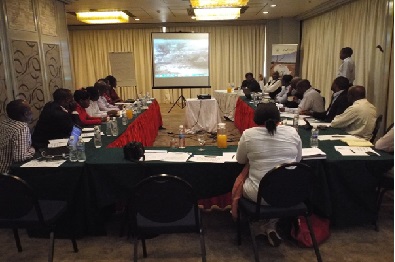The workshop which brought together 18 participants was held at Rainbow Towers, Harare. The expected workshop outputs were; getting more information on the DRR situation within the basin, understanding of the gaps, challenges, issues and opportunities relating to DRR in the basin, coming up with a framework and guidance for the actions that can be included in the Limpopo Commission (LIMCOM) DRR Action Plan and having an understanding of the way forward with regards to the development of the DRR Action Plan.
Mr Wellington Dzvairo, Water Climate and Development Programme (WACDEP) Zimbabwe Programme Manager gave the objectives of the workshop. In his presentation, he noted that the workshop aimed at obtaining expert and stakeholder inputs and comments in order to develop principles, strategies and complementary activities for the LIMCOM Disaster Risk Reduction Action Plan. Overall the objectives entailed;
- To develop transboundary principles and approaches on how to reduce disasters and risks in the Limpopo Basin;
- Engage stakeholders in identifying what is currently being done at riparian state level, what are the gaps, challenges and issues within the basin;
- To identify opportunities to reduce vulnerability to floods and droughts at all levels within the basin i.e. regional, transboundary, national and local levels and
- To contribute to developing actions for the Limpopo Basin DRR Action Plan based on the challenges, issues and opportunities identified so that basin is better prepared to prepare, mitigate, respond and recover from disasters.
Participants also had the opportunity to gain a better understanding on the background to the development of the Limpopo River Basin DRR Action Plan. Dr Moleele who gave the presentation noted that water scarcity poses the greatest threat to livelihoods, economies and ecosystems of the LRB. He also noted that water demand is more than what is produced in the Basin therefore; enabling sufficient access to water is the most important way of reducing vulnerability in the LRB system. In order to address that, investments that focus on the key themes of biodiversity, water, and climate change can make a significant contribution towards increasing water-use efficiency and availability. He also added that, protecting and restoring areas of environmental degradation is a basin priority given the strong relationship between water quantity, quality, and biodiversity.
In his presentation, he also highlighted that groundwater provides hope for increasing water supply in the LRB, but the sustainability of groundwater supplies is limited by under-resourced and low-capacity management practices. He emphasized the need to prioritize food security by promoting sustainable agriculture for alleviating poverty and building secure livelihoods. Additionally, balancing community needs with a politically coordinated approach to managing water scarcity was also noted as key. So the questions that need to be addressed are; what mechanisms are there at the Basin level to address these disasters, how do we warn each other of high water levels in the Basin and what needs to be improved to ensure disasters in the Basin are addressed?
Mr Betera representing the Department of Civil Protection also presented on the disaster Risk Management in Zimbabwe process, challenges and lessons learnt. He noted that water related disasters being experienced in the Basin are as follows; flooding, flash floods, tropical cyclones, droughts, mid-season dry spells, extreme temperatures, thunderstorms, hail storms, lightning, ground frost, climate change. Other sensitive hazards include malaria and water borne disasters. He added that the country has a legislative framework where the government commitment in the management of disasters is demonstrated by the existence of the legal enabling statutes, which create an enabling environment for disaster risk reduction initiatives. Major achievements and ongoing DRR programmes include; integration of DRM in education system, improved communication network coverage, MOUs with neighbouring countries for the management of transboundary disasters, capacity building programmes supported by UNDP, public awareness campaigns and conducting lessons learnt seminars for major disasters.
The Department of Civil Protection faces major challenges that include; inadequate and centralisation of resources, damaged infrastructures, manpower and financial resources, decision making and information flow has tended to be bureaucratic, general socio economic challenges undermine country capacity for early recovery, lack of enforcement of legislation and damaged infrastructure remain unattended for prolonged periods resulting in accessibility problems.
Mr Ramaano shared with participants that in country consultations were undertaken in the four riparian countries and these were followed by the regional inception workshop. Thereafter more consultations are being undertaken in all the four riparian countries and the idea is to get the actual ideas that can be included in the Action Plan. He noted that the framework is aimed at helping us understand; how the factors that influence resilience in system are currently (Status quo), identify the issues and challenges on these underlying factors with regards to building a resilient system to droughts and floods and focus also on projected climate risks.
Participants were then divided into 2 groups to look at what action needs to be taken to address the challenge at the different levels and also to identify the possible implementing agent(s). Thereafter group feedback was given by the group rapporteurs. In mapping the way forward, Mr Ramaano noted that in country consultations in Mozambique will be held the following week. Then the team would consolidate and synthesise what was derived from all 4 countries, produce a draft that will be circulated to all stakeholders for input. Then in mid-February to March a regional workshop will be organised to ensure that the team produces a final draft to be submitted to LIMCOM.
